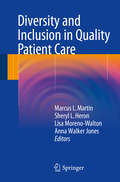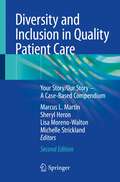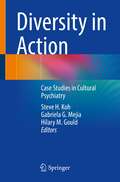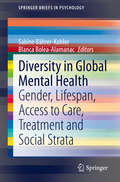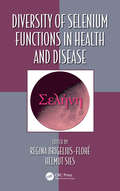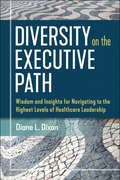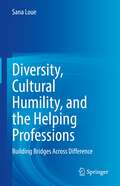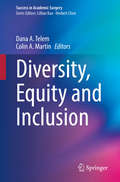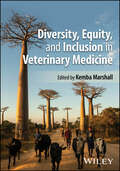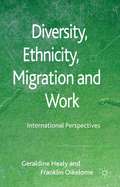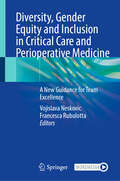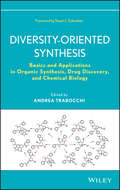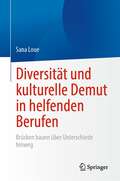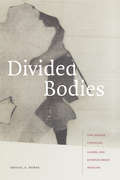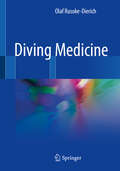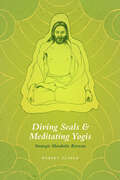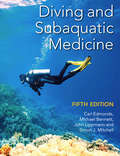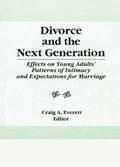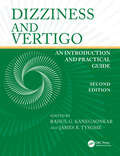- Table View
- List View
Diversity and Inclusion in Quality Patient Care
by Marcus L. Martin Sheryl L. Heron Lisa Moreno-Walton Anna Walker JonesNo other hospital department cares for patients as diverse as those who come to the Emergency Department (ED). These patients encompass all stages and positions of life and health. Many belong to distinct minority cultures defined by the patient's sexual orientation and gender identity, disability, spirituality, language, race, and ethnicity. It has been well documented that minorities experience inadequate emergency treatment and face poorer healthcare outcomes. Furthermore, research has established that the elderly, ethnic minorities, the poor, and persons with Medicaid coverage are more likely than other people to utilize the emergency department rather than primary care services. With the passage of the Affordable Care Act, particularly the Medicaid expansion, EDs across the United States are poised to care for an unprecedented number of underserved minorities. The need to equip emergency healthcare professionals to practice medicine that is culturally competent in the broadest possible sense has never been greater. Diversity and Inclusion in Quality Patient Care aims to fill this need.
Diversity and Inclusion in Quality Patient Care: Your Story/our Story - A Case-based Compendium
by Marcus L. Martin Lisa Moreno-Walton Sheryl Heron Michelle StricklandThis new edition focuses on bias in health care and provides a variety of case examples related to the timely topics of unconscious bias and microaggressions encountered by patients, students, attending and resident physicians, nurses, staff, and advanced practice providers in various healthcare settings. The proliferation of literature on unconscious bias and microaggressions has raised public awareness around these concerns. This case compendium discusses strategies and addresses professional responses to bias in health care and extends beyond the individual patient and healthcare provider into the communities where biased assumptions and attitudes exist. Recognizing that ethnic minorities, the elderly, the poor, and persons with Medicaid coverage utilize the emergency department at higher rates than the general population, this compendium also builds upon the case studies from the first edition to cover a broader array of underserved minority groups. Diversity and Inclusion in Quality Patient Care: Your Story/Our Story – A Case-Based Compendium, 2nd Edition is an essential resource for attending and resident physicians, nurses, staff, advanced practice providers, and students in emergency medicine, primary care, and public health.
Diversity in Action: Case Studies in Cultural Psychiatry
by Steve H. Koh Gabriela G. Mejia Hilary M. GouldThis book presents an extensive collection of high-yield case vignettes with recommendations for a comprehensive approach to cultural psychiatry. Culture is defined from an anthropological perspective, with an emphasis on aspects of culture beyond race, ethnicity, and other traditional demographic categories. The goal of this book is to offer clinical applications of cultural psychiatry via examination of special populations, systems, and settings. With ever-changing geopolitical environments, institutional structures, and sociodynamics, attention and consideration of context is paramount. Theoretical models and specific frameworks for evaluating cultural influence on the manifestation, development, and treatment response of mental health illnesses are presented. The chapters are organized to showcase different ways in which culture plays into everyday clinical practice. Emphasis is placed on the full sum of the care delivery transaction within a larger context, including public and community systems of care. Real-world case examples are discussed in each chapter to help contextualize the dynamic nature that culture plays in practice across inpatient and outpatient settings. Each case presents with relevant academic and historical background and practical operational advice for psychiatrists providing care within these respective communities. The authors address diverse clinical cases related to refugee and asylum seekers, military service members, survivors of human trafficking, incarcerated populations, and more. Training recommendations and best practices are outlined including psychopharmacology, psychosocial treatments, and cultural adaptations to evidence based treatments.Diversity in Action: Case Studies in Cultural Psychiatry is a useful resource for all psychiatrists, psychologists, general practitioners, social workers, nurses, administrators, public policy officials, and all medical professionals working with a culturally diverse subset of patients seeking mental health.
Diversity in Career Preferences of Future Health Workers in Rwanda: Where, Why, and For How Much?
by Tomas Lievens Pieter Serneels Agnes Soucat Jean Damascene ButeraRelying on unique survey data, this paper analyzes the career preferences of future health workers in Rwanda, focusing on their sector preferences, their willingness to work in rural areas, their likelihood to migrate abroad, and their readiness to work in a high HIV prevalence environment. The findings show that health workers are not as uniform as is often thought, and can have very different preferences regarding wages, intrinsic motivation, and attitudes toward risk. But there are commonalities among future health workers, and the results highlight the importance of intrinsic motivation. To improve health policies, many governments have identified human resources in the health field as a policy priority. To improve policies, this paper provides evidence on health workers' choices and behavior, and it will be a valuable resource for government officials to design effective human resource policies. This working paper was produced as part of the World Bank's Africa Region Health Systems for Outcomes (HSO) Program. The Program, funded by the World Bank, the Government of Norway, the Government of the United Kingdom, and the Global Alliance for Vaccines and Immunization (GAVI), focuses on strengthening health systems in Africa to reach the poor and achieve tangible results related to Health, Nutrition, and Population. The main pillars and focus of the program center on knowledge and capacity building related to Human Resources for Health, Health Financing, Pharmaceuticals, Governance and Service Delivery, and Infrastructure and ICT.
Diversity in Global Mental Health: Gender, Lifespan, Access to Care, Treatment and Social Strata (SpringerBriefs in Psychology)
by Sabine Bährer-Kohler Blanca Bolea-AlamanacMental illness occurs in all communities, regardless of social status, gender, race, or culture. Despite this, research in mental health historically has been biased towards Western-centric heterosexual male models of disease. Many models of service have excluded sexual and ethnic minorities and may not have been inclusive of different cultures or spiritual approaches. All of these factors may in turn isolate these communities and thus lead to an increased vulnerability to disease. This brief explores the diversity of cultural, ethnic, social, and gender perspectives on how to achieve better mental health care for societies across the globe. The authors emphasize diversity focusing on lifespan aspects, while weaving in social, racial, ethnic, cultural, and gender perspectives. They further expand their analysis by zeroing in on prominent determinants in global mental health care, including globalization, international migration, specific population idiosyncrasies, climate change, and political context. Finally, it includes novel neurobiological and biomedical approaches to treatment, and a suggestions of how those can be implemented from the perspective of diversity and gender inclusiveness. Diversity in Global Mental Health will be of great interest to experts and researchers in behavioral medicine, as well as practitioners and educators working in global mental health promotion and prevention of mental illness and related fields such as psychology, social policy, and public health.
Diversity of Selenium Functions in Health and Disease
by Regina Brigelius-Flohé Helmut SiesNamed after Selene, Greek goddess of the moon, selenium (Se) has moved has moved from being thought of as a toxicant to being considered an essential nutrient with the potential to reduce cancer risk in the span of seven decades. Diversity of Selenium Functions in Health and Disease focuses on current knowledge of aspects of Se research relevant to
Diversity on the Executive Path: Wisdom And Navigating To The Highest Levels Of Healthcare Leadership (ACHE Management)
by Diane DixonComing September 2019 As the US population continues to diversify, the business case for diversity in healthcare leadership is becoming increasingly evident. Racially and ethnically diverse leaders are, however, still significantly underrepresented in today’s C-suites. How can healthcare leaders close this gap to enhance the cultural competence of their organizations and improve health equity for all? In Diversity on the Executive Path, author Diane L. Dixon tackles this pressing issue by sharing the real-life experiences of 12 racially and ethnically diverse hospital and health system CEOs. Dixon conducted in-depth, face-to-face interviews with this highly accomplished group of healthcare executives to discover what it takes to become a leader at the highest level. From their experiences, you will gain insight and learn practical lessons you can apply to your own career journey or the journeys of those you mentor, coach, or sponsor. The book delves into topics such as: • Reflections on race and ethnicity in healthcare leadership • The essential role of sponsorship •Strategies for maximizing career mobility • Navigating a career path when the going gets tough • Leadership that makes a difference Each chapter features executive commentary from additional healthcare leaders—practical advice for navigating the executive path—and concludes with questions that invite you to reflect on your own experiences and identify meaningful practices for building success. The path to the C-suite is not a step ladder; it is a complex journey with many twists and turns. This book presents a unique opportunity to learn from the career trajectories of diverse healthcare executives. May they inspire and enrich your own journey.
Diversity, Cultural Humility, and the Helping Professions: Building Bridges Across Difference
by Sana LoueToo often, cultural competence training has led to the inadvertent marginalization of some individuals and groups and the reinforcement of existing stereotypes. This text explores the concept of cultural humility, which offers an exciting way forward for those engaged in the helping professions. In contrast to cultural competence, cultural humility challenges individuals to embark on a lifelong course of self-examination and transformational learning that will enable them to engage more authentically with clients, patients, colleagues, and others. The book traces our understanding of and responses to diversity and inclusion over time with a focus on the United States.Topics explored include:Us and Them: The Construction of CategoriesCultural Competence as an Approach to Understanding DifferenceTransformational Learning Through Cultural HumilityFostering Cultural Humility in the Institutional/Organizational ContextCultural Humility and the Helping ProfessionalThe book presents examples that illustrate how the concept of cultural humility can be implemented on an institutional level and in the context of individual-level interactions, such as those between a healthcare provider or therapist and a client.Diversity, Cultural Humility, and the Helping Professions: Building Bridges Across Difference is essential reading for the health professions (nursing, medicine), social work, psychology, art therapy, and other helping professions.
Diversity, Equity and Inclusion (Success in Academic Surgery)
by Dana A. Telem Colin A. MartinThis book comprehensively covers diversity, equity and inclusion (DEI) in the context of daily surgical practice. Through real-life illustrative case scenarios and experiences, this book explores DEI and its impact on academic surgery, career development, and clinical practice. Each chapter highlights a commonly encountered scenario and features extensive guidance on how to address each challenge secondary to both implicit explicit biases as well as detailing how to implement best practices. Diversity, Equity and Inclusion provides a detailed guide to the best practices and challenges associated with implementing DEI in day to day surgical practice and is a valuable resource for all surgical practitioners looking for a guide on how to successfully implement DEI strategies into daily clinical practice.
Diversity, Equity, and Inclusion in Veterinary Medicine
by Kemba MarshallAn insightful discussion of DEI and its application to a wide variety of real-world veterinary settings Diversity, Equity, and Inclusion in Veterinary Medicine takes a broad approach to the concept of DEI, delivering a practical discussion of effective strategies for applying diversity, equity, and inclusion (DEI) practices within the veterinary setting. Written by a diverse set of voices, the book provides a comprehensive understanding of DEI as it relates to veterinary medicine. Arranged from A to Z, the 26 chapters discuss important concepts in DEI, with actionable advice for how to incorporate DEI into the practice of veterinary medicine. The chapters define the concepts, explain why each concept is important to veterinary medicine, and give practical examples of how to apply the concepts in the real world. Each chapter stands on its own and can be approached individually but taken together these chapters expand the boundaries of DEI into topics that are both familiar and novel. Readers will also find: A thorough introduction to the concept of access to care and one health medicine through the lens of DEI Comprehensive explorations of equity, intersectionality, justice, representation, and other central DEI concepts that impact the veterinary profession’s ability to benefit society Practical discussions of how unconscious bias and cultural competency impact both client and team interactions impacting patient care In-depth examinations of specific community engagement, including First Nation, queer, and neurodiverse communities Diversity, Equity, and Inclusion in Veterinary Medicine is an invaluable resource for practicing veterinarians, veterinary technicians, veterinary practice managers, other veterinary professionals, veterinary students, veterinary technician students, and anyone involved with animal health.
Diversity, Ethnicity, Migration and Work
by Geraldine Healy Franklin OikelomeThe contemporary relevance of Diversity, Ethnicity, Migration and Work is evident in debates on migration, racism and the global market in healthcare workers. It is about work and workers in the health care sector across three continents and in particular the UK, USA and Nigeria, focusing on highly qualified and skilled professional and low paid workers. This book is informed by current thinking on migration, ethnicity and work, including critical engagement with the literature on diasporas, social networks, social processes, anti-racism and feminism and diversity. The authors provide an historical and global perspective before engaging deeply with the working experience of highly qualified international migrants and low paid migrant and minority workers. They provide unique comparative and intersectional insights into the experience of migrant doctors compared to UK and US qualified doctors and deepen this understanding by an exploration of women doctors' experiences. The story of frontline low paid migrant and black and minority ethnic workers is told drawing on social process and the means of challenging inequalities through trade unions and social networks as well as diversity management strategies.
Diversity, Gender Equity and Inclusion in Critical Care and Perioperative Medicine: A New Guidance for Team Excellence
by Vojislava Neskovic Francesca RubulottaThis book highlights the disparity between the growing number of women entering medical school and their underrepresentation in leadership roles within Critical Care and perioperative medicine. Despite numerous reviews and reports on gender and minority gaps, few resources offer practical solutions. Improving the working environment is essential. The book focuses on practical examples and tools that can be easily adopted by readers. It addresses the well-being of practitioners and the safety, outcomes, and patient-centered care for patients. Post-pandemic data show significant burnout in Critical Care and anaesthesia, disproportionately affecting women and minorities, with long-term consequences for the workforce and care quality. The Triple Aim—enhancing patient experience, improving population health, and reducing costs—is a framework for optimizing healthcare performance. Burnout, however, is linked to lower patient satisfaction, poorer health outcomes, and increased costs. This has led to the Quadruple Aim, which includes improving the well-being of healthcare providers. Preventing burnout is vital for maintaining productivity and care quality. Enhancing research and professional well-being in Critical Care and anaesthesia directly improves patient care quality. Patient-centered care is a core objective. Improving the working environment, preventing burnout, enabling professionals to achieve their goals, and addressing diversity are key to improving outcomes and care quality. This book provides a practical approach to improving team well-being, outcomes, safety, and patient satisfaction in high-risk healthcare environments. It offers relevant information and highlights areas for improvement in Critical Care and perioperative settings, helping healthcare professionals achieve their goals.
Diversity-Oriented Synthesis
by Stuart L. Schreiber Andrea TrabocchiDiscover an enhanced synthetic approach to developing and screening chemical compound librariesDiversity-oriented synthesis is a new paradigm for developing large collections of structurally diverse small molecules as probes to investigate biological pathways. This book presents the most effective methods in diversity-oriented synthesis for creating small molecule collections. It offers tested and proven strategies for developing diversity-oriented synthetic libraries and screening methods for identifying ligands. Lastly, it explores some promising new applications based on diversity-oriented synthesis that have the potential to dramatically advance studies in drug discovery and chemical biology.Diversity-Oriented Synthesis begins with an introductory chapter that explores the basics, including a discussion of the relationship between diversity-oriented synthesis and classic combinatorial chemistry. Divided into four parts, the book:Offers key chemical methods for the generation of small molecules using diversity-oriented principles, including peptidomimetics and macrocyclesExpands on the concept of diversity-oriented synthesis by describing chemical librariesProvides modern approaches to screening diversity-oriented synthetic libraries, including high-throughput and high-content screening, small molecule microarrays, and smart screening assaysPresents the applications of diversity-oriented synthetic libraries and small molecules in drug discovery and chemical biology, reporting the results of key studies and forecasting the role of diversity-oriented synthesis in future biomedical researchThis book has been written and edited by leading international experts in organic synthesis and its applications. Their contributions are based on a thorough review of the current literature as well as their own firsthand experience developing synthetic methods and applications.Clearly written and extensively referenced, Diversity-Oriented Synthesis introduces novices to this highly promising field of research and serves as a springboard for experts to advance their own research studies and develop new applications.
Diversität und kulturelle Demut in helfenden Berufen: Brücken bauen über Unterschiede hinweg
by Sana LoueAllzu oft hat die Ausbildung in kultureller Kompetenz zu einer unbeabsichtigten Ausgrenzung einiger Personen und Gruppen und zur Verstärkung bestehender Stereotypen geführt. Dieser Text erforscht das Konzept der kulturellen Demut, das einen spannenden Weg nach vorne für diejenigen bietet, die in helfenden Berufen tätig sind. Im Gegensatz zu kultureller Kompetenz fordert kulturelle Demut den Einzelnen heraus, sich auf einen lebenslangen Kurs der Selbstprüfung und des transformativen Lernens einzulassen, der es ihm ermöglicht, authentischer mit Klienten, Patienten, Kollegen und anderen umzugehen. Das Buch zeichnet unser Verständnis von und unsere Reaktionen auf Vielfalt und Integration im Laufe der Zeit nach, wobei der Schwerpunkt auf den Vereinigten Staaten liegt.Zu den untersuchten Themen gehören:Wir und die Anderen: Die Konstruktion von KategorienKulturelle Kompetenz als Ansatz zum Verstehen von UnterschiedenTransformatives Lernen durch kulturelle BescheidenheitFörderung von kultureller Demut im institutionellen/organisatorischen KontextKulturelle Demut und die helfende FachkraftDas Buch zeigt anhand von Beispielen, wie das Konzept der kulturellen Bescheidenheit auf institutioneller Ebene und im Kontext individueller Interaktionen, z. B. zwischen einem Gesundheitsdienstleister oder Therapeuten und einem Klienten, umgesetzt werden kann.Diversität, kulturelle Demut und die helfenden Berufe: Building Bridges Across Difference" ist eine unverzichtbare Lektüre für Gesundheitsberufe (Krankenpflege, Medizin), Sozialarbeit, Psychologie, Kunsttherapie und andere helfende Berufe.
Divided Bodies: Lyme Disease, Contested Illness, and Evidence-Based Medicine (Critical Global Health: Evidence, Efficacy, Ethnography)
by Abigail A. DumesWhile many doctors claim that Lyme disease—a tick-borne bacterial infection—is easily diagnosed and treated, other doctors and the patients they care for argue that it can persist beyond standard antibiotic treatment in the form of chronic Lyme disease. In Divided Bodies, Abigail A. Dumes offers an ethnographic exploration of the Lyme disease controversy that sheds light on the relationship between contested illness and evidence-based medicine in the United States. Drawing on fieldwork among Lyme patients, doctors, and scientists, Dumes formulates the notion of divided bodies: she argues that contested illnesses are disorders characterized by the division of bodies of thought in which the patient's experience is often in conflict with how it is perceived. Dumes also shows how evidence-based medicine has paradoxically amplified differences in practice and opinion by providing a platform of legitimacy on which interested parties—patients, doctors, scientists, politicians—can make claims to medical truth.
Divided Brains
by Lesley J. Rogers Giorgio Vallortigara Richard J. AndrewAsymmetry of the brain and behavior (lateralization) has traditionally been considered unique to humans. However, research has shown that this phenomenon is widespread throughout the vertebrate kingdom and found even in some invertebrate species. A similar basic plan of organization exists across vertebrates. Summarizing the evidence and highlighting research from the last twenty years, the authors discuss lateralization from four perspectives - function, evolution, development and causation - covering a wide range of animals, including humans. The evolution of lateralization is traced from our earliest ancestors, through fish and reptiles to birds and mammals. The benefits of having a divided brain are discussed, as well as the influence of experience on its development. A final chapter discusses outstanding problems and areas for further investigation. Experts in this field, the authors present the latest scientific knowledge clearly and engagingly, making this a valuable tool for anyone interested in the biology and behavior of brain asymmetries.
Diving Medical Acupuncture: Treatment and Prevention of Diving Medical Problems with a Focus on ENT Disorders
by Will Maclean Janneke VermeulenWritten for acupuncturists and Chinese medicine practitioners, this book describes the medical conditions that can prevent, complicate or result from diving and other water sports, and provides effective clinical treatments. The most common problems experienced by divers - ear, nose and throat (ENT) disorders - can be effectively treated with acupuncture. Through in-depth knowledge of Western diving medicine, diving techniques and Chinese medicine, the author prescribes acupuncture diagnostics and treatment for these ENT disorders. Complete with anatomical diagrams and acupuncture point charts, this is a practical resource for acupuncture clinicians who deal with the issues associated with diving. Advice for patients is given at the end of each chapter, and is available as a handout in downloadable form.
Diving Medicine
by Olaf Rusoke-DierichThis book is the very first to cover the decompression theory in detail. It gives many information on all topics of the diving medicine, and is richly and uniquely illustrated. It offers a good guideline of high quality practice in diving medicine. The author provides a very structured and easy to understand book, by covering all aspects of the diving medicine, such as equipment, physiology, and related issues as gas intoxications, venomous animals or damages that can occur in the diving practice. Relevant physiological and anatomical illustrations enlight even complex topics. The Diving medicine book will appeal to health experts like doctors and nurses, but also to diving schools and teachers
Diving Physiology of Marine Mammals and Seabirds
by Paul J. PonganisAnalysing the physiological adaptations of marine mammals and seabirds, this book provides a comprehensive overview of what allows these species to overcome the challenges of diving to depth on a single breath of air. Through comparative reviews of texts on diving physiology and behaviour from the last seventy-five years, Ponganis combines this research into one succinct volume. Investigating the diving performance of marine mammals and seabirds, this book illustrates how physiological processes to extreme hypoxia and pressure are relevant to the advancement of our understanding of basic cellular processes and human pathologies. This book underscores the biomedical and ecological relevance of the anatomical, physiological and molecular/biophysical adaptations of these animals to enable further research in this area. An important resource for students and researchers, this text not only provides an essential overview of recent research in the field, but will stimulate further research into the behaviour and physiology of diving.
Diving Seals and Meditating Yogis: Strategic Metabolic Retreats
by Robert ElsnerThe comparative physiology of seemingly disparate organisms often serves as a surprising pathway to biological enlightenment. How appropriate, then, that Robert Elsner sheds new light on the remarkable physiology of diving seals through comparison with members of our own species on quests toward enlightenment: meditating yogis. As Elsner reveals, survival in extreme conditions such as those faced by seals is often not about running for cover or coming up for air, but rather about working within the confines of an environment and suppressing normal bodily function. Animals in this withdrawn state display reduced resting metabolic rates and are temporarily less dependent upon customary levels of oxygen. For diving seals creatures especially well-adapted to prolonged submergence in the ocean s cold depths such periods of rest lengthen dive endurance. But while human divers share modest, brief adjustments of suppressed metabolism with diving seals, it is the practiced response achieved during deep meditation that is characterized by metabolic rates well below normal levels, sometimes even approaching those of non-exercising diving seals. And the comparison does not end here: hibernating animals, infants during birth, near-drowning victims, and clams at low tide all also display similarly reduced metabolisms. By investigating these states and the regulatory functions that help maintain them across a range of species, Elsner offers suggestive insight into the linked biology of survival and well-being. "
Diving and Subaquatic Medicine
by Michael Bennett Carl Edmonds John Lippmann Simon MitchellConsidered an essential resource by many in the field, Diving and Subaquatic Medicine remains the leading text on diving medicine, written to fulfil the requirements of any general physician wishing to advise their patients appropriately when a diving trip is planned, for those accompanying diving expeditions or when a doctor is required to assess
Divorce Mediation: Perspectives on the Field
by Craig EverettHere is an excellent introduction to and overview of the field of divorce mediation, a field that has grown rapidly and achieved a remarkable level of recognition among both the clinical and legal professions in the last decade. Divorce Mediation describes the process and some of the techniques of mediation, as well as mediation theory and training. Authorities from marriage and family therapy and law--all practicing mediators--address the ability of women to negotiate for themselves in mediation, describe several approaches to handling custody issues, and discuss several challenging issues facing the profession, including who should practice mediation, what are the boundaries and ethics of practice, and how does mediation relate to the traditional disciplines of law, psychology, marriage and family therapy, and social work. Summaries of actual case studies are especially helpful in illustrating how mediators accomplish their negotiations.
Divorce and the Next Generation: Effects on Young Adults' Patterns of Intimacy and Expectations for Marriage
by Craig EverettThis informative book clarifies the complex picture of how the experience of divorce in one generation may influence the next generation’s approach to and preparedness for marriage. It identifies research and clinical issues regarding the effects of the parental divorce experience on young adults’patterns of dating, attachment, and mate selection. Divorce and the Next Generation focuses primarily on young adults and the patterns and attitudes regarding intimacy and attachment that they will carry into their own adult marriages.The book contains research studies which compare differing variables of developmental achievement, personal adjustment, and attitudes of children from divorced and nondivorced families. The implications of these findings for understanding the intergenerational effect from divorce in one generation to marriage in the next are crucial as they guide professionals in their work with young adults and divorcing families in clinical and educational settings. This enlightening volume provides a foundation and a stimulus for more research into these dynamics. Divorce and the Next Generation addresses topics such as: the effects of childhood family structure and perceptions of parental marital happiness on marital and parenting aspirations differences in intimate relationships between college students from divorced and intact families a literature review of short- and long-term effects of parental divorce on children the effects of conflict and family structure on attitudes toward marriage and divorce differences in marriage role expectations between college students of divorced and intact families effects of parental divorce on children in Erikson’s identity stage indirect effects of parental divorce on self-concept via changes in family environment correlates of self-esteem among college-age offspring from divorced familiesDivorce and the Next Generation is full of useful information for beginning and advanced family therapists, marital counselors, family and psychological researchers, and other professionals interested in the effects divorce has on the families involved.
Dixmont State Hospital
by Mark BentonPittsburgh natives have recognized Dixmont State Hospital by its towering boiler house smokestack that stood prominently along busy Route 65. It has been a topic of curiosity, urban exploration, ghost hunts, and historical research; but prior to its closing in 1984, Dixmont State Hospital stood as a refuge to the mentally ill for three counties in western Pennsylvania. A majestic study in the Kirkbride design of asylum architecture, Dixmont was originally built by the Western Pennsylvania Hospital in 1859 as a private venture before being bought by the commonwealth. It was named for famed mental health care reformer Dorothea Dix, who was instrumental in choosing the hospital's site--a site chosen for its tranquility and its view of the Ohio River. Dixmont was completely razed in January 2006 to make way for a multi-parcel commercial endeavor. But for those who spent time there, Dixmont was a vibrant community within a community. Through historic photographs, Dixmont State Hospital opens up this world that was off limits to the general public but was alive with festivals, celebrations, and the successful treatment of patients.
Dizziness and Vertigo: An Introduction and Practical Guide
by James R. Tysome Rahul G. KanegaonkarDizziness and Vertigo describes the basic knowledge and practical skills necessary for managing patients presenting with common symptoms of dizziness and vertigo. It provides practitioners with a comprehensive overview of these conditions, steps for diagnosing patients and various treatment options.This revised and updated edition provides a framework for the accurate diagnosis and management of patients with dizziness and vertigo, covering clinical assessments and case studies. It also includes new methods for treating Ménière’s disease and benign paroxysmal positional vertigo (BPPV) and in the field of vestibular rehabilitation.Dizziness and Vertigo is an essential reference for all those who manage patients in the outpatient setting, including general practice trainees, ear/nose/throat (ENT) specialists and physiotherapists.
